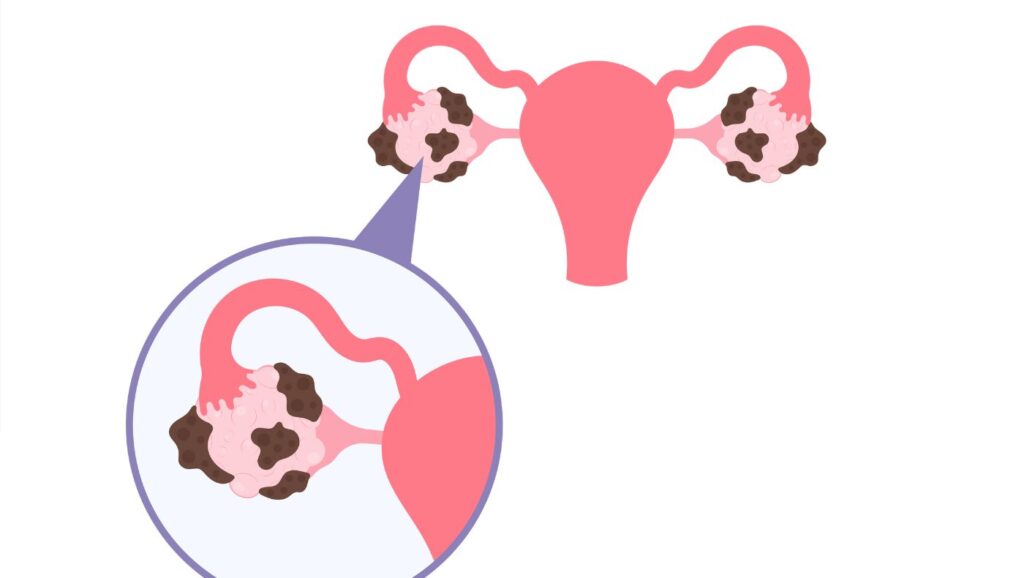
Endometriosis: Symptoms, Causes, and Treatment – Your Ultimate Guide
Let’s talk about something that affects 1 in 10 women but is often misunderstood: endometriosis. If you’ve ever experienced excruciating period pain or struggled with unexplained infertility, you might be familiar with this condition. But what exactly is endometriosis? What are the symptoms of endometriosis, and what causes endometriosis? More importantly, how can you manage it? In this blog, we’ll break it all down—symptoms, causes, types, and even endometriosis treatment options. So, grab a cuppa, and let’s dive in!
What is Endometriosis?
Imagine your uterus throwing a party, but the guests (endometrial tissue) decide to crash other organs like the ovaries, fallopian tubes, or even the bladder. That’s endometriosis in a nutshell. It’s a condition where tissue similar to the lining of the uterus grows outside the uterus, causing pain, inflammation, and sometimes infertility.
While it’s a common condition, it’s often underdiagnosed because the symptoms of endometriosis can be mistaken for “just bad periods.” But trust us, it’s so much more than that.
Endometriosis Symptoms: What to Look Out For
The symptoms of endometriosis can vary from mild to debilitating. Here are the most common signs to watch for:
- Painful Periods: We’re not talking about your average cramps. This is next-level pain that can leave you bedridden.
- Chronic Pelvic Pain: Pain that lingers even when you’re not on your period.
- Pain During Sex: If intimacy feels more like agony than pleasure, endometriosis could be the culprit.
- Heavy Bleeding: Soaking through pads or tampons every hour? That’s not normal.
- Infertility: For some women, endometriosis is discovered during fertility investigations.
- Digestive Issues: Bloating, constipation, or diarrhoea, especially during your period.
If you’re nodding along to these symptoms of endometriosis, it’s time to chat with your doctor.
What Causes Endometriosis?
Now, let’s tackle the million-dollar question: what causes endometriosis? While the exact cause of endometriosis is still a mystery, scientists have a few theories:
- Retrograde Menstruation: This is when menstrual blood flows backward into the pelvis instead of out of the body.
- Genetic Factors: If your mum or sister has endometriosis, you’re more likely to develop it too.
- Hormonal Imbalances: Oestrogen seems to fuel the growth of endometrial tissue.
- Immune System Issues: A weakened immune system might fail to clear out misplaced tissue.
- Environmental Factors: Exposure to certain toxins may increase the risk.
While we don’t have all the answers yet, ongoing research into the causes of endometriosis is shedding more light on this complex condition.
Types of Endometriosis
Did you know there are different endometriosis types? Yep, it’s not a one-size-fits-all condition. Here’s a quick rundown:
- Superficial Peritoneal Endometriosis: The mildest form, where lesions grow on the peritoneum (the lining of the pelvis).
- Ovarian Endometriomas: Also known as “chocolate cysts,” these form on the ovaries.
- Deep Infiltrating Endometriosis (DIE): The most severe type, where tissue grows deep into the pelvic organs.
Understanding the endometriosis types can help tailor treatment to your specific needs.
Endometriosis Treatment: What Are Your Options?
When it comes to endometriosis treatment, there’s no one-size-fits-all solution. Here are the most common options:
1. Pain Relief
- Over-the-counter painkillers like ibuprofen can help manage mild symptoms.
2. Hormonal Therapies
- Birth Control Pills: These can regulate your cycle and reduce pain.
- GnRH Agonists: These drugs lower oestrogen levels, putting you into a temporary menopause-like state.
3. Surgery
- Laparoscopy: A minimally invasive procedure to remove endometrial tissue.
- Hysterectomy: In severe cases, removing the uterus may be an option.
4. Supportive Therapies
- Endometriosis supportive therapy includes things like physiotherapy, counselling, and lifestyle changes to improve your quality of life.
How to Prevent Endometriosis
While there’s no surefire way to prevent endometriosis, some lifestyle changes might help reduce your risk:
- Exercise Regularly: Physical activity can help regulate hormones and reduce inflammation.
- Eat a Balanced Diet: Focus on anti-inflammatory foods like fruits, veggies, and omega-3-rich fish.
- Limit Alcohol and Caffeine: These can disrupt hormone balance.
- Manage Stress: Chronic stress can wreak havoc on your body, so find healthy ways to relax.
Living with Endometriosis: Tips for Better Health
Managing endometriosis is a marathon, not a sprint. Here are some tips to help you cope:
- Educate Yourself: The more you know about endometriosis symptoms and causes of endometriosis, the better equipped you’ll be to advocate for yourself.
- Build a Support Network: Whether it’s friends, family, or a support group, don’t go it alone.
- Prioritise Self-Care: Listen to your body and give it the rest it needs.
- Stay Positive: It’s easier said than done, but a positive mindset can make a world of difference.
Conclusion
Endometriosis might be a tough opponent, but it’s not unbeatable. By understanding the symptoms of endometriosis, exploring its causes, and working with your doctor to find the right treatment, you can take control of your health.
Remember, you’re not alone in this journey. With the right support and information, you can manage endometriosis and live a full, vibrant life. For expert care and guidance, visit Ovum Fertility to take the next step toward better health.
FAQs
1. What are the most common symptoms of endometriosis?
The most common endometriosis symptoms include painful periods, chronic pelvic pain, pain during sex, and heavy bleeding.
2. What causes endometriosis?
While the exact cause of endometriosis is unknown, theories include retrograde menstruation, genetic factors, and hormonal imbalances.
3. Can endometriosis be prevented?
While there’s no guaranteed way to prevent endometriosis, lifestyle changes like regular exercise and a healthy diet may help reduce your risk.
4. What are the treatment options for endometriosis?
Endometriosis treatment options include pain relief, hormonal therapies, surgery, and endometriosis supportive therapy.
5. Are there different types of endometriosis?
Yes, the main endometriosis types are superficial peritoneal endometriosis, ovarian endometriomas, and deep infiltrating endometriosis.
By understanding endometriosis and taking proactive steps, you can navigate this condition with confidence. Here’s to better health and brighter days ahead!